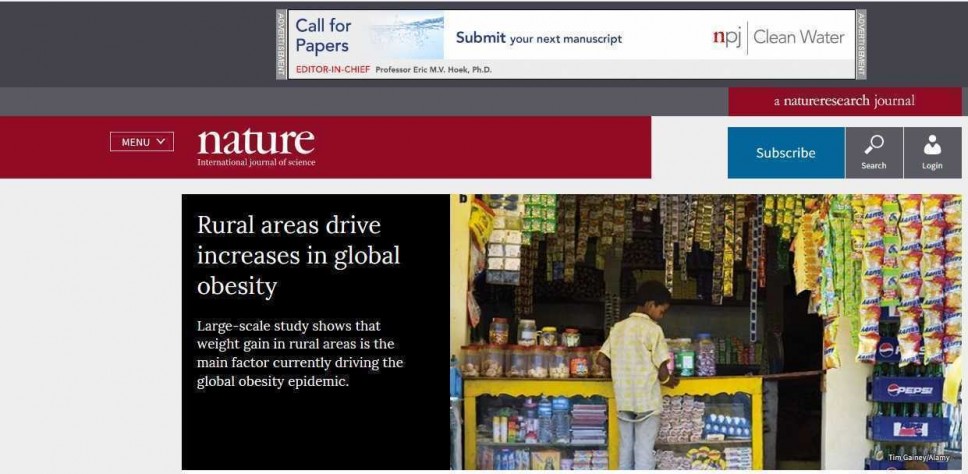Discovery of World Scientists: Obesity Higher in Villages than Cities at the Global Level

Scientific paper published in one prestigious world scientific journals ‘Nature’, signed also by Dusko Bjelica, PhD and Stevo Popovic, PhD two Montenegrin scientists at the Faculty of Sport and Physical Education of the University of Montenegro, among other authors, asserts the data that obesity is faster increasing in rural than in urban areas of the world.
Scientific paper titled ‘Rising rural body-mass index is the main driver of the global obesity epidemic in adults’ represents a new survey on global body mass (BMI), conducted by the group of scientists gathered at the Imperial College from London.
This survey, which has found its place in the world journal with 41.58 impact factor, analysed data on height and weight of more than 112 million adults in urban and rural areas in over 200 countries and territories, for the period from 1985 to 2017.
‘It is known the height and weight may be used for calculating BMI, internationally recognized scale indicating whether an individual has adequate weights compared to height’, Dusko Bjelica, PhD emphasizes.
Survey, involving the network of more than 1 000 researchers over the world, showed the BMI of women rose in average by 2.0 kg/m2 and 2,2% kg/m2 of men at the global level from 1985 to 2017, which means that each person is heavier by around six kilograms.
‘More than half of the global growth within the period of 33 years presents a result of BMI increase in rural areas’, Stevo Popovic, PhD highlights.
He adds rural areas of countries with low and middle revenue caused more than 80% of increase.
When it comes to concrete rural areas, the research team discovered the increase of average BMI by 2,1 kg/m2 of women and man achieved since 1985, whereas the increase in cities amounted to 1.3 kg.m2 of women and 1.6 kg/m2 of men.
These trends caused astounding changes in the relief of the BMI over last three decades.
Men and women in urban areas had higher BMI than their rural countrymen in more than three quarter of surveyed states in 1985.
Over time, gap between urban and rural BM in many of these countries has been reduced or even reversed.
‘Results of this vast global study repeal generally accepted perception of life in urban environment and its inhabitants as a main cause of global obesity growth’, Dusko Bjelica, PhD explains. ‘It gives a new motive for contemplating and approach to this global health problem.’
Difference between states with high, middle and low revenue
Professor Popovic emphasizes ‘The significant differences between states with high, middle and low revenue are determined in our study’.
Survey showed that BMI has been significantly higher in rural areas in states with a high revenue since 1985, especially for women.
Authors of this study say these results are the outcome of life conditions deficiency in rural areas at the global level: lower incomes and education, constrained accessibility, higher healthy food price, the lack of free and sport contents.
‘Discussions on public health had the tendency to be more focused on negative life aspects in cities’, Professor Bjelica said, ‘however, cities provide a wide range of possibilities for better nutrition, more intensified physical activity and reaction, as well as overall improved health, and resolution of obesity problem in rural areas from now on’.
In meanwhile, the revenue growth as well as better infrastructure, mechanization development in agriculture and increase of cars is noticed in rural areas, in countries with low and middle revenue, which led to numerous health benefits, but also to lower energy consumption, as well as more significant allocation funds foreseen for food, which was frequently of poorer quality, since enough good regulations did not exist.
All these factors contribute to more rapid BMI increase in rural areas.
‘As countries become richer, a challenge for rural inhabitants is being changed from: enough to meet needs for food, to food of proper quality’, Professor Bjelica adds.
Professor Bjelica mentioned the exception of the global trend met in sub-Sahara Africa where women in towns were gaining weight faster. The answer probably lies in jobs requiring lower energy consumption (such as office jobs) where there is lower need for physical household works, and in a short distance between house and office, as well as greater access to processed foodstuffs.
The article is available on https://www.nature.com/articles/s41586-019-1171-x or at home page www.nature.com
1) Difference between rural and urban age-standardized BMI of men
2) Difference between rural and urban age-standardized BMI of women
3) Trends in age-standardized BMI according to rural and urban place of residence
https://m.portalanalitika.me/clanak/334107/gojazniji-u-selu-nego-u-gradu-na-globalnom-nivou
https://volimpodgoricu.me/2019/05/12/svjetski-naucnici-dokazali-gojazniji-u-selu-nego-u-gradu-na-globalnom-nivou/
http://www.antenam.net/drustvo/119979-svjetski-naucnici-dokazali-gojazniji-u-selu-nego-u-gradu
https://www.mina.news/crnagora/svjetski-naucnici-dokazali-gojazniji-u-selu-nego-u-gradu/
http://www.rtcg.me/vijesti/drustvo/240293/gojazniji-u-selu-nego-u-gradu.html
https://fosmedia.me/mobile/infos/drustvo/svjetski-naucnici-dokazali-gojazniji-u-selu-nego-u-gradu

